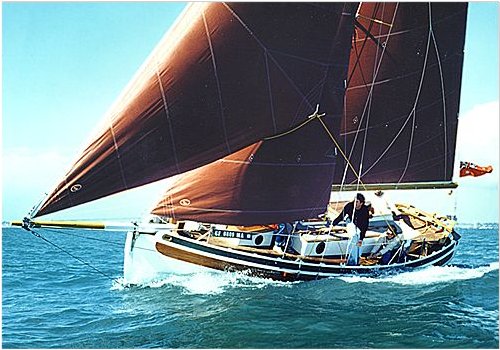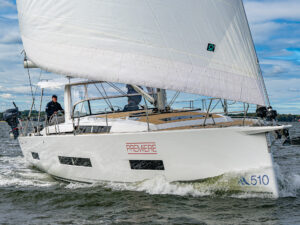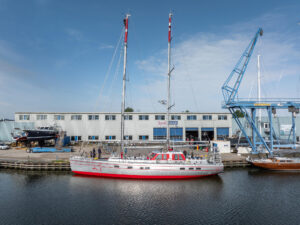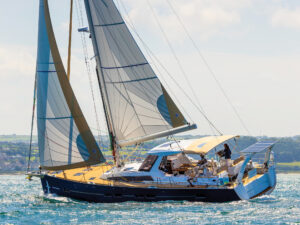
The Bristol Channel Cutter caused a veritable traffic jam at the 1995 Annapolis Boat Show. Certainly she is a niche boat with a fiercely loyal following among long-distance cruisers. Cruiser/authors Lin and Larry Pardey, whose boats Seraffyn and Taleisin are also Lyle Hess designs, have always been big proponents of her style. Traditional lines, a long full keel and heavy displacement set her apart from many modern cruising boats.
Careful workmanship and structural integrity are givens. The hull is hand-laid and squeegeed to optimize the fabric-to-resin ratio. Up to 10 layers of mat, roving and cloth combine to form a thickness that ranges from 3/8-inch at the sheer to a whopping one to 11/2 inches at the bottom of the hull; additional reinforcement can be found in the chain plate area. The hull comes protected with three coats of epoxy barrier coat to retard osmotic blistering.
Deck construction features marine plywood core. While it is heavier than balsa core and does not enjoy the same core-skin shear strength, marine ply has good compressive strength and will not absorb water readily if holed or drilled in an unexpected area.
Below the waterline, the cutter is built to take the abuse of long-distance passage making and the bumps and bruises that follow inevitably from poking into uncharted anchorages. The 5’1″ full keel is formed from pre-cast lead ballast that is completely resin encapsulated, then covered with mat and roving. The double-spreader aluminum mast is stepped solidly on this substantial keel. The rudder is transom hung, not only making it easy to remove and repair but also enabling it to protect the propeller in an aperture behind the keel.
The hull-to-deck joint is sealed in 3M 5200, then fastened with 1/4-inch stainless steel bolts on five-inch centers. The deck joint is strengthened further by the addition of bulwark stanchions installed every 20 inches using 1/2-inch stainless bolts.
Wide side decks flanked by 28-inch lifelines and eight-inch-high teak bulwarks provide exceptional security whenever you venture forward. Shrouds and chain plates fastened outboard provide an unobstructed passage fore and aft. Double anchor rollers fitted to a sturdy bracket on the bowsprit increase the options for anchoring in tight spaces.
Cockpit seats are flush with the deck. Board inserts span the cockpit well and cushions from below fit into this space to make a double bed topside beneath the stars, with a thin 10-inch-high wood cockpit coaming separating the enclosure from the side decks. The companionway entrance is protected by a sizable bridge deck, lessening the chances of green water spilling below even if the hatchboards are left out inadvertently.
The headsail attached to the end of a six-foot bowsprit moves the center of effort forward for improved off-the-wind performance and a more balanced helm. The trade-off is that, even with roller furling, if the sail becomes jammed or must be changed one has to go forward and sit on the end of the bowsprit to complete the task. The cutter rig does, however, offer nice balance between the staysail (deck mounted) and the main or storm trysail when the going gets tough.
Solid construction in hull and deck add up to a formidable heavy displacement boat. Despite its modest length (28 feet on deck), the Bristol Channel Cutter has the ability to carry a sizable payload of cruising equipment and provisions. The disadvantages include slow performance and compromised maneuverability in light air. However, in many people’s minds heavy displacement equates to seaworthiness. I sense that the boat may be overbuilt, but in the end this is a judgment call that anybody faced with an evening aground on an uncharted reef might energetically dispute.
Because the rudder is not balanced, all mechanical advantage is provided by the tiller. Manning the helm for any significant amount of time without tackle led to bear weather load is apt to be strenuous. Prolonged steering is probably best accomplished by sail trim, wind vane or autopilot, for which the boat is by design exquisitely adapted; a simple wind vane operating off a trim tab on the rudder steered better than we could in our light-air Chesapeake Bay testing venue.
I’ve been impressed by consistent reports of good blue-water performance by owners of these venerable craft.
The interior is entirely hand fabricated; no liners are used. What this means is easy access to the hull and flexibility in interior layout. There are three basic layout options, but you can semi-customize your cutter in a lot of cases without extra cost. Below, the boat exudes quiet, snug warmth. Classic touches such as bronze ports, an opening teak skylight and brass decorative plates for ventilation recall 19th century craftsmanship and careful attention to detail.
And with 6’1″ (optionally 6’6″) headroom, the interior feels surprisingly roomy. The pull-out pilot berth can convert into a double, and the companionway stairs can be lifted and latched for easy access to an altogether spacious engine compartment. There is even the option of a large workbench forward instead of a single berth. Anchor chain stowage is located in a locker low and aft of the stemhead — where the weight should be.
Galley layout is particularly well planned. With a flip-up counter extension, this little 28-footer has more counter space than do some 42-footers I’ve sailed. A generous 70 gallons of water in the keel and good storage throughout allow you to provision for long passages.
The BCC reflects quite beautifully a cruising philosophy wherein solid construction, first-class workmanship and displacement heavy enough to carry gear and stand up to a gale at sea reign supreme. At $157,000 (price as tested) this one may seem expensive, but down the road it represents terrific value. If you want to cruise in a proven conservative design, in a boat that has and will withstand the tests of time, the Bristol Channel Cutter demands your careful attention.
Specs
- LOA (w/sprit): 37’9″ (11.5 m.)
- LOD: 28’1″ (8.6 m.)
- LWL: 26’3″ (8.0 m.)
- Beam: 10’1″ (3.1 m.)
- Draft: 4’10” (1.48 m.)
- Ballast: 4,600 lbs. (2,087 kgs.)
- Disp: 14,000 lbs. (6,351 kgs.)
- SA (100%): 556 sq.ft. (51.7 sq.m.)
- Mast above water: 41’6″ (12.7 m.)
- Ballast/Disp: .33
- Disp/Length: 345
- SA/Disp: 15.3
- Fuel tankage: 32 gal. (121 ltr.)
- Water tankage: 73 gal. (276 ltr.)
- Auxiliary: Yanmar 3GM30F 27-hp diesel
- Cabin headroom: 6’6″ (1.98 m.)
- Designer: Lyle C. Hess
- Base price: approx. $150,000
Sam L. Morse Company Inc.
1626 Placentia Ave.
Costa Mesa, CA 92627
Phone:(714) 645-1834








